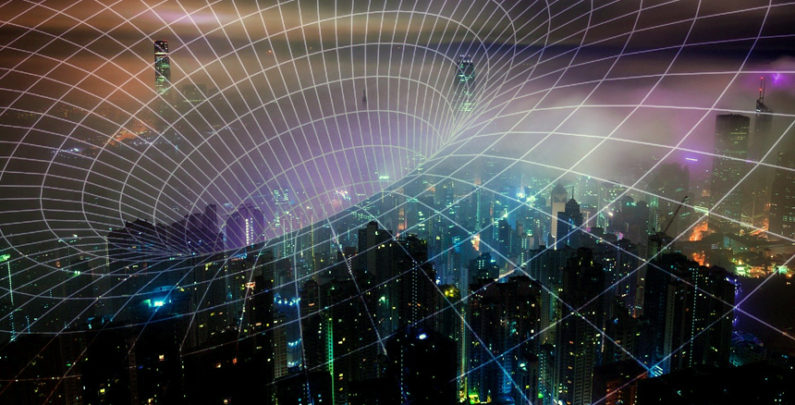
This is how fast the world will change in ten years
It wasn’t supposed to be like this.
Futurists from the 20th century predicted that labor saving devices would make leisure abundant. According to the great economist John Maynard Keynes, the big challenge would be that…
“For the first time since his creation man will be faced with his real, his permanent problem — how to use his freedom from pressing economic cares, how to occupy the leisure, which science and compound interest will have won for him, to live wisely and agreeably and well.”
— John Maynard Keynes (1930)

Fast forward almost a century later.
Things didn’t quite go as expected. This quote from a modern researcher captures the current ethos:
“Rather than being bored to death, our actual challenge is to avoid anxiety attacks, psychotic breakdowns, heart attacks, and strokes resulting from being accelerated to death.”
— Geoffrey West
Rather than inhabiting a world of time wealth, we’re inhabiting a world of time poverty. Rather than feeling the luxury of time freedom, we’re feeling the burden of constant hurry.
What happened?
How did things turn out the exact opposite of what we were expecting?
More importantly, will the pace of life keep accelerating? And if it does, what are the implications (ie — can most people even cope)? What should we be doing now as knowledge workers to prepare for this future?
So, I spent over 100 hours reading the top 10 books related to these questions across the disciplines of sociology, technology, physics, evolution, business, and systems theory.
I read Pressed for Time: The Acceleration of Life in Digital Capitalism by sociologist Judy Wajcman. I read The Sociology of Speed: Digital, Organizational, and Social Temporalities by ten sociologists. I read Scale: The Universal Laws of Life, Growth, and Death in Organisms, Cities, and Companies by physicist turned polymath Geoffrey West. I reread The Singularity Is Near by technologist and futurist Ray Kurzweil. I read The Red Queen: Sex and the Evolution of Human Nature by journalist Matt Ridley, PhD. I read about the Law Of Requisite Variety pioneered in the field of cybernetics. Finally, I read Competing Against Time: How Time-Based Competition is Reshaping Global Markets by management consultant George Stalk and Clockspeed: Winning Industry Control In The Age Of Temporary Advantage by MIT researcher Charles Fine.
While each of these researchers provide a different perspective, they point to the same fundamental root cause…
Time Is Accelerating Because Of The Red Queen Effect
At a fundamental level, life on earth must compete to stay alive. Predators and prey are in a never-ending race to evolve new abilities to avoid extinction. Rabbits that evolve longer ears to hear foxes survive more. Foxes that develop stronger legs to run faster catch more rabbits and don’t starve. And so on.
Matt Ridley, author of The Red Queen Effect, explains the tit for tat like this…
If a competitor makes an improvement, you must make an equal or greater improvement just to stay neck-and-neck with them. Stay the same and you fall behind.
Lauren Bacall said it even better…
“Standing still is the fastest way of moving backwards in a rapidly changing world.”
— Lauren Bacall
n other words, evolution is a double-edged sword. On one hand, innovations increase survival. On the other hand, they also increase competition, which reduces survival.
Evolution does not rest on its laurels. It accelerates.
Enter humans.
With humans, we see a shift from competing based on biology to competing based on ideas (cultures, strategies, technologies, etc.). For example…
- Companies compete for top talent. Employees compete for open positions.
- Employees compete to move up the corporate ladder.
- Companies compete for investors. Investors compete for the best startups.
- Companies compete against each other via their products and services.
- Scientists compete against each other for publication, citation, awards, and funding.
- Everyone competes for attention.
Just like evolution, when we evolve new technologies, things don’t slow down and become a utopia. Rather things get faster and more competitive.
Now, here’s where the big difference between biology and ideas is. While human biology evolves so slowly we don’t notice, ideas (cultures, strategies, technologies, etc.) evolve so quickly, we can’t keep up. Idea evolution is like biological evolution on steroids.
In other words, in a moment when many are already feeling overwhelmed by change, things are about to take off even faster. 20 years from now, the rate of change will be 4x what it is now. Things will keep accelerating from there, and in 40 years, it will be 16x (more on these numbers later).
What does this mean?
Let me put it in context. For many, 2020 felt like five years packed into one…
- Historic pandemic
- Historic social movement (Black Lives Matter)
- Historic stimulus
- Historic wildfires
- Historic election
- Historic stock market high
- Historic technology breakthroughs (Alphafold / GPT-3 / Quantum Supremacy, etc)
We saw once-in-a-generation events in nearly every sphere of life. Each of these events rippled throughout society leading to unpredictable second-order effects which upended our long-held beliefs about media, democracy, business, and citizenship to name a few. Our emotions went from positive to negative extremes as we faced unprecedented opportunities and challenges. We had to fundamentally rethink our lives, relationships, and work.
Here’s the thing though… 2020 isn’t a temporary blip before things go back to normal. It is the kickoff to an unprecedented acceleration that few have considered, let alone prepared for.
If time is like a treadmill, 2020 was running. The near-future will be an all out sprint.
How do we keep up?
To answer this question, let’s talk about…
The Coming Acceleration Shock
“If somebody describes the world of the mid-twenty-first century to you and it doesn’t sound like science fiction, it is certainly false. We cannot be sure of the specifics; change itself is the only certainty.”
— Yuval Noah Harari
While both biology and ideas evolve exponentially, exponential growth is fundamentally different at different stages of the curve. It starts off slowly, but when it hits the knee of the curve, it grows explosively and profoundly.
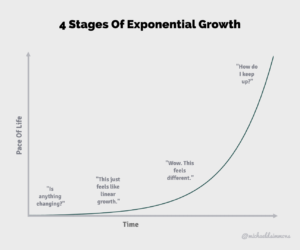
For example, one researcher charted the Gross World Product from 10,000 BCE to 2019 and came up with this chart…
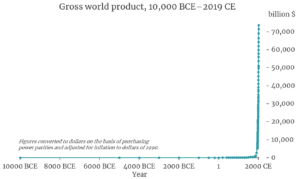
We are now living in the second half of the curve. This is a big deal, because the second half feels and behaves in fundamentally different ways.
Ray Kurzweil, the director of engineering at Google and arguably the world #1 futurist, breaks down what the second half of the exponential curve better than anyone else in his book, The Singularity Is Near.
Kurzweil’s basic premise is this…
“The future will be far more surprising than most people realize.”
The reason it’ll be more surprising, he argues, is, “because few observers have truly internalized the implications of the fact that the rate of change itself is accelerating.” In other words, “an exponential curve looks like a straight line when examined for only a brief duration. As a result, even sophisticated commentators, when considering the future, typically extrapolate the current pace of change over the next ten years or one hundred years to determine their expectations.”
Let’s break this down. When we look at a linear and exponential curve from a zoomed out perspective of more time, it’s easy to see the difference between the two curves…
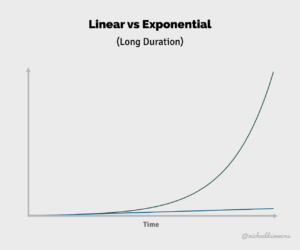
However, when we zoom into a small duration, the differences look more like this. Notice that the difference is almost impossible to see.
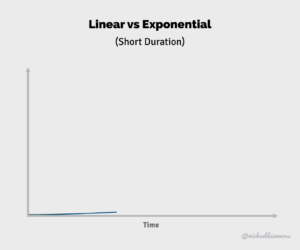
For example, I was born in 1981. When I think about the pace of change, it is hard for me to compare the change I experienced in my lifetime to the change experienced during 1940–1980. It’s like comparing apples to oranges. Furthermore, when I look at the last 40 years, major events blend together. The pace changes, but then I get used to it. It is hard to feel the exponential nature either way. Sure, I can intellectually understand exponential change, but I don’t feel it.
Things get really interesting when Kurzweil shares the implications of this insight. It is the most profound, yet underappreciated idea from the book…
Introducing The 10-Year Rule
“My models show that we are doubling the paradigm-shift rate every decade.”
— Ray Kurzweil
This is the most interesting line in Kurzweil’s book in my opinion. This statement is profound, because it means the following…
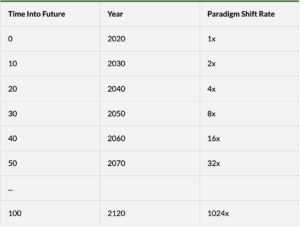
To put this chart in context, 20 years from now, the rate of change will be 4x what is now. Said differently, for someone who is about 40 today, when they’re 60 in 2040, the rate of paradigm change will be 4x what it is now. They will experience a year of change (by today’s standards) in three months. For someone who is 10 today, when they’re 60, they’ll experience a year of change in 11 days.
To summarize the profundity of this 10-year doubling rate, Kurzweil says…
“We won’t experience one hundred years of technological advance in the twenty-first century; we will witness on the order of twenty thousand years of progress (again, when measured by today’s rate of progress), or about one thousand times greater than what was achieved in the twentieth century.”
Let that sink in for a second.
So what exactly is a paradigm and how did Kurzweil come up with this rate?
To create the 10-Year Rule, Kurzweil plotted the largest milestones of biological and technological development on a single graph…
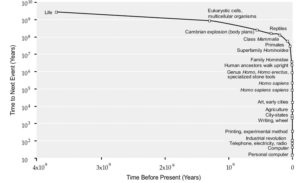
Kurzweil’s key events roughly mirror reference books that have compiled the most important historical events (Encyclopaedia Britannica, the American Museum of Natural History, Carl Sagan’s “cosmic calendar,” and others).
Of course, because there is a trend in the past, it doesn’t mean it will continue in the future. But, the way I see it, if a trend has existed on Earth for a billion years, it’s worth at least planning for the possibility that it will happen in the next 20 years.
And if you want to see how ridiculously predictable technological progress has been for the last 60 years, I recommend watching this video. It is awe-inspiring…
This quote captures the importance of Moore’s Law to the technology industry…
“If Silicon Valley has a heartbeat, it’s Moore’s Law,”
— Rob Enderle
This all begs the question…
What would it mean to have the rate of paradigm changing events be 4x what it is now in 20 years?
How To Prepare For The Coming Acceleration Shock
“When an industry is subjected to an important innovation, that industry typically feels a significant uptick in the overall clockspeed.”
— Charles Fine (MIT)
As I mentioned, the rapid evolution of human culture, ideas, strategies, and technology is a double-edged sword. On one hand, innovations increase efficiency. On the other hand, it also increases competition.
This happens on three levels:
- Race against people. People and companies are using their efficiency gains to double down and gain further advantage thus increasing the competition even more. For example, in Silicon Valley, the epicenter of the tech, many of the smartest and wealthiest people in the world are working 60–80 hours per week and making sacrifices in their families, health and sleep in order to do so. Large salaries are put toward nannies, drivers, cleaners, and everything such that time at work can be maximized.
- Race against machines. To compete on costs, companies are using robots and AI to eliminate jobs. In the economics literature, this is known as the race against machines. Many technologies automate old jobs and create the opportunities for new jobs. But, to take advantage of these opportunities, individuals must be able to “race” faster than machines by learning new skills. We see the harbingers of automation with cashierless stores (3.6M jobs in US) and autonomous vehicles (2M truck drivers in US) and robofactories (12M+ manufacturing jobs in US). These three job categories alone account for over 10% of the US workforce, and they’re almost guaranteed to precipitously downsize in the next 10 years.
- Race against the world. Digitization has taken extreme competition to a whole other level. Rather than competing against the best in your local area, you’re competing against the best in the world. In other words, rather than competing against a small number of people, you’re competing against 1,000x the number of people. The result of global competition is that competition is exponentially more fierce and winner-take-all.
I first experienced what it was like to go from local to global competition while I grew up playing tennis. I was #1 player on my high school tennis team for all four years. And, I was one of the top five players in the state for my age. This meant I went into nearly every match expecting to win. A few times I even played several points with my opposite hand out of boredom.
Things flipped when I went to a national level. I expected to always lose unless I got lucky. The players there weren’t just a little bit better, they were dominant. I felt like a mouse being played with by a cat. Like a perpetual outsider.
At the global level, these dominant US players were dominated by the international competition. Then, at the next professional level when all of the top global players are thrown into one pile no matter their age, only the top 100 or so players make enough money to even play tennis full-time. Then, within the top professional players, Roger Federer, Rafael Nadal, and Novak Djokovic have combined to win 57 of the past 67 Slams. Out of all of the hundreds of men’s professional tennis players, only three account for almost all of the attention, prize money, and endorsements over the last decade. It’s brutal when you think about it. That’s what it’s like when markets go global and digital.
What does the extreme competition mean?
On the positive side, this increasing competition creates incredible innovation. As consumers, we have people racing to serve needs we didn’t even realize we had faster, cheaper, and better.
On the negative side, as workers, we are the ones racing to serve customers. It feels like we’re on a treadmill and that if we get off that treadmill to smell the roses of life for too long, we may fall irreparably behind. If there isn’t always a direct threat we can see, there is always the implied threat. For example, there is now a large literature of megacompanies who were disrupted by garage startups because their innovation rate slowed and their hubris swelled.
Matt Ridley sums up the situation in this quote…
“One of the peculiar features of history is that time always erodes advantage. Every invention sooner or later leads to a counterinvention. Every success contains the seeds of its own overthrow. Every hegemony comes to an end. Evolutionary history is no different. Progress and success are always relative… In history and in evolution, progress is always a futile, Sisyphean struggle to stay in the same relative place by getting ever better at things.”
— Matt Ridley
Some harbingers of this reality are already around us.
For starters, the lifespan of companies on the Fortune 500 is shrinking. Charles Fine, MIT researcher and author of Clockspeed puts these numbers in context, “The faster the industry clockspeed, the shorter the half-life of competitive advantage.”
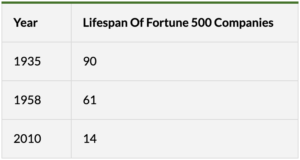
We’re also seeing inequality skyrocket. One of the craziest statistics here is that the world’s 2,153 billionaires have more wealth than 4.6 billion people combined, according to Oxfam. Even more surprising, the 26 richest people own as much as the poorest 50%. It’s astounding.
We can also see how the pace of life has increased on many other levels…
Movies have faster cuts. When my kids were younger, I took it as an opportunity to rewatch the first Star Wars. It was too slow to keep my attention.
More and more people are fast forwarding media content. Netflix recently added the ability to watch all of its shows at 1.5x speed. Even Audible recently increased its max speed from 3x to 3.5x.
Our language is becoming shorter, more informal, and filled with acronyms…
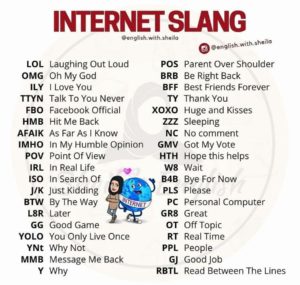
We’re seeing book summary websites get venture capital and now websites that offer book summaries of book summaries.
Not too long ago, Google Calendar added 15 minute increments. Will it soon copy Elon Musk’s 5-minute increments?
Finally, we’ve all heard about increasing rates of anxiety. Many times social media usage and technology devices are scapegoated as the root cause. But maybe all of these are part of a deeper phenomenon… time acceleration.
What We Can Do About Time Acceleration In Our Careers
“In order to keep up with the world of 2050, you will need not merely to invent new ideas and products but above all to reinvent yourself again and again.”
— Yuval Noah Harari
To recap, we are on the precipice of an era of extreme competition — which means that the amount and pace of competition will accelerate 4x in the next 20 years.
If you don’t prepare now, you will be progressively outcompeted and overwhelmed.
So the question becomes, how do you want to run the race?
A few options emerge…
- Follow the pace of the crowd: In other words, do what most people are doing (i.e. get a 9–5 job and do what’s expected of you). This is the least stressful option in the short-term, but you risk falling behind in the long-term.
- Work harder than others: This helps you progress in your career faster, but you sacrifice time with family & friends along with personal health… not to mention that you risk losing out to people who are learning more than you.
- Outlearn others and let your knowledge compound: Learning is the ultimate productivity hack. In other words, it provides the greatest leverage. It’s the tool that the greatest innovators and business thinkers of our time (Elon Musk, Jeff Bezos, Bill Gates, Warren Buffett, and others) use to get ahead.
I’ve personally gone with option #3 because of the power of the 5-Hour Rule…
The 5-Hour Rule: The Antidote To The Exploding Pace Of Modern Life
“Read 500 pages every day. That’s how knowledge works. It builds up, like compound interest. All of you can do it, but I guarantee not many of you will do it.”
— Warren Buffett
The 5-Hour Rule is the surprising pattern that many of the busiest and most successful people in the world find at least 5 hours per week for learning.
The beauty of the 5-Hour Rule is that you don’t have to work yourself to death, you can have fun learning, and you don’t have to make huge personal sacrifices.
When you set aside an hour in your day for deliberate learning, your productivity for the day may decrease, but your productivity over your life skyrockets as your knowledge compounds.
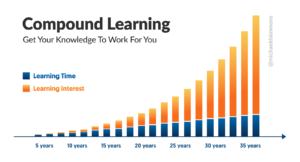
Over time, you are living more and more off of the compound interest from your learning. As a result, you can go faster and faster with less and less effort.
And that’s why I spend 3–4 hours per day learning as an entrepreneur.
How To Apply The 5-Hour Rule To Your Life
If you see the power of learning like I do, I would love to support you on your learning journey.
This article is the first in my free training series on how to learn and succeed in the radically different future we’re all entering. Each of the five lessons took me over 50 hours to research and write, and is based on my experience reading over 2,000 books, building multiple 7-figure businesses, and teaching thousands of students how to learn faster.
In this free training series, I will help you…
- Overcome information overwhelm (the №1 reason why most learners fall behind, and fail to get real-world results from their learning)
- Find breakthrough knowledge that gives you a lasting competitive edge (and ultimately transforms your life)
- Use a simple memorization strategy that Greeks and Romans used to remember what they learned (that is also backed by science)
- Find time in your busy schedule to build a bulletproof learning habit
Each lesson comes with a summary video and free worksheet to help you apply the lesson.









